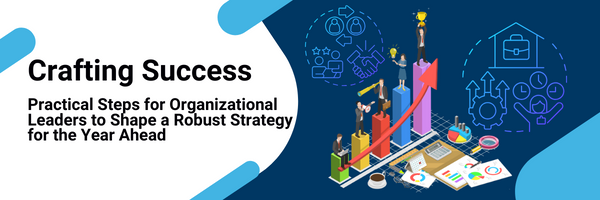Crafting Success: Practical Steps for Organizational Leaders to Shape a Robust Strategy for the Year Ahead
- See the World at Work Crafting Success: Practical Steps for Organizational Leaders to Shape a Robust Strategy for the Year Ahead

In the dynamic landscape of business, organizational success hinges on the ability to navigate challenges, seize opportunities, and stay ahead of the curve. As we embark on a new year, it's the perfect time for organizational leaders to fine-tune their strategies, ensuring they are not only resilient but poised for growth. In this article, we'll explore practical steps that can guide leaders in shaping a robust strategy for the upcoming year.
1. Illuminate Your Path with a SWOT Analysis:
A strategic journey begins with self-awareness. Conduct a comprehensive SWOT analysis—delve into your organization's Strengths, Weaknesses, Opportunities, and Threats. This introspective exercise lays the foundation for a strategy that capitalizes on internal strengths while addressing potential challenges.
2. Set Sail with Clear Objectives:
Goals provide direction, and clear objectives offer a roadmap to success. Utilize the SMART criteria (Specific, Measurable, Achievable, Relevant, Time-bound) to articulate objectives that resonate throughout the organization. A shared vision ensures everyone is pulling in the same direction.
3. Harness Collective Wisdom through Stakeholder Involvement:
The synergy of diverse perspectives can elevate your strategy. Involve key stakeholders—employees, customers, partners—in the decision-making process. Their insights bring a richness that can lead to innovative solutions and foster a sense of collective ownership.
4. Market Mastery through Continuous Research:
In the ever-evolving business landscape, knowledge is power. Stay informed about industry trends, customer preferences, and competitive dynamics. Regular market research provides the intelligence needed to make informed decisions and gain a competitive edge.
5. Budgeting Brilliance and Resource Allocation:
Efficient resource allocation is the backbone of strategic success. Develop a meticulous budget aligned with your objectives, ensuring that departments have the resources they need. A well-funded strategy is a strategy set up for accomplishment.
6. Navigate Challenges with Effective Risk Management:
No strategy is foolproof, but effective risk management can mitigate potential pitfalls. Identify risks, develop contingency plans, and embrace a proactive approach. Preparedness in the face of challenges ensures smoother sailing.
7. Technological Triumph:
In the digital era, technology is a powerful ally. Embrace relevant advancements to enhance efficiency and effectiveness. Whether it's implementing new software or automating processes, technology integration can elevate your strategy to new heights.
8. Empower Your Greatest Asset: Your Team
Invest in the growth and development of your workforce. Well-trained and motivated employees are essential for successful strategy execution. A skilled team not only meets objectives but propels the organization towards its vision.
9. Keep Score with Key Performance Indicators (KPIs):
Measure what matters. Define and track Key Performance Indicators (KPIs) regularly to gauge progress. This data-driven approach provides valuable insights, helping you steer the ship towards success.
10. Communicate Clearly with a Comprehensive Plan:
Communication is the compass that keeps everyone on course. Develop a clear and comprehensive communication plan. Ensure every member of the organization understands the strategy, their role in it, and the ongoing progress.
11. Flexibility and Adaptability:
Acknowledge the fluidity of the business environment. Embrace an agile and adaptive approach. Be ready to adjust your strategy based on market changes, customer feedback, and unexpected challenges. Flexibility is the key to sustained success.
12. Regular Review and Reflection:
Success is not a destination but a journey. Schedule regular reviews to assess strategy progress. Use feedback and performance data to make informed adjustments or refinements. A strategy that evolves with intention is a strategy that thrives.
13. Customer Satisfaction is King:
Happy customers are the heartbeat of any thriving organization. Keep a close eye on customer feedback and satisfaction. A satisfied customer not only returns but becomes a brand advocate, contributing to long-term success.
14. Legal and Ethical Excellence:
Navigate the business landscape ethically and legally. Ensure that your strategy aligns with industry regulations and standards. A commitment to legal and ethical practices builds trust and credibility.
15. Sustainability and CSR for a Brighter Future:
Elevate your strategy by incorporating sustainable practices and Corporate Social Responsibility (CSR) initiatives. Not only does this contribute to a positive impact on the community and the environment, but it also enhances your brand reputation in the eyes of socially conscious consumers.
As organizational leaders embark on the journey of a new year, the roadmap to success is clear: a robust strategy that blends foresight, adaptability, and a commitment to continuous improvement. By implementing these practical steps, leaders can steer their organizations towards a future defined by resilience, growth, and lasting success. Cheers to a year of strategic triumphs!
Related Content




Comments